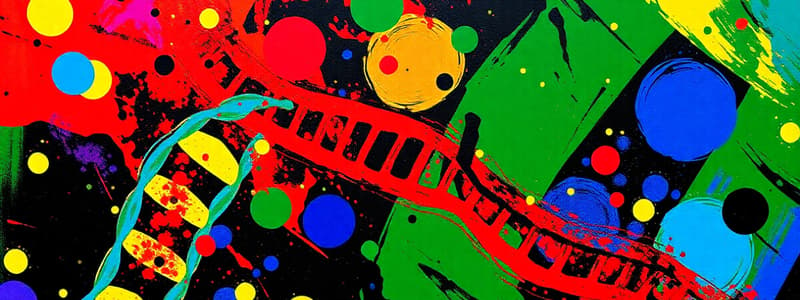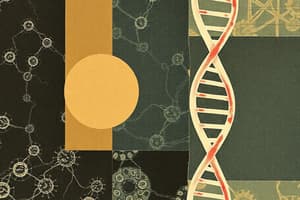Podcast
Questions and Answers
What mechanism allows for the replication of the lagging strand in chromosomes?
What mechanism allows for the replication of the lagging strand in chromosomes?
- Continuous synthesis of DNA
- Special mechanism involving telomerase (correct)
- Direct repair of DNA
- Use of histone proteins
What is the approximate length of the diploid human genome?
What is the approximate length of the diploid human genome?
- 2.1 m (correct)
- 6.369 million bp
- 4.5 billion bp
- 700 m
Which structure facilitates the compaction of DNA in chromosomes?
Which structure facilitates the compaction of DNA in chromosomes?
- Histone proteins
- Nucleosome (correct)
- Telomeres
- Chromatin fibers
How do chromosomes behave during mitosis in terms of structure?
How do chromosomes behave during mitosis in terms of structure?
What role do telomeres play in DNA organization?
What role do telomeres play in DNA organization?
What is the accuracy rate of DNA polymerase during DNA replication?
What is the accuracy rate of DNA polymerase during DNA replication?
What role do RNA primers play in DNA synthesis?
What role do RNA primers play in DNA synthesis?
How many replication origins are estimated to exist in the human genome?
How many replication origins are estimated to exist in the human genome?
Which direction does DNA polymerase synthesize DNA?
Which direction does DNA polymerase synthesize DNA?
What are Okazaki fragments?
What are Okazaki fragments?
What is the consequence of the 'end-replication problem' in DNA synthesis?
What is the consequence of the 'end-replication problem' in DNA synthesis?
What happens to RNA primers after DNA synthesis?
What happens to RNA primers after DNA synthesis?
Which of the following statements is true about DNA polymerase's function?
Which of the following statements is true about DNA polymerase's function?
What is the function of primase in DNA replication?
What is the function of primase in DNA replication?
How fast can DNA polymerase replicate deoxynucleotides?
How fast can DNA polymerase replicate deoxynucleotides?
What is the significance of the orientation of the sugar-phosphate backbone in DNA?
What is the significance of the orientation of the sugar-phosphate backbone in DNA?
How many base pairs are typically involved in one complete turn of the DNA helix?
How many base pairs are typically involved in one complete turn of the DNA helix?
What is the length of the total DNA present in a human body?
What is the length of the total DNA present in a human body?
In which direction does DNA polymerase add new deoxynucleotides during replication?
In which direction does DNA polymerase add new deoxynucleotides during replication?
What type of replication does DNA undergo?
What type of replication does DNA undergo?
What is the total number of base pairs estimated in the human genome?
What is the total number of base pairs estimated in the human genome?
Which of the following statements is true regarding DNA base-pairs?
Which of the following statements is true regarding DNA base-pairs?
What is the estimated total number of cells in the human body?
What is the estimated total number of cells in the human body?
What type of bond is typically considered the strongest among chemical interactions?
What type of bond is typically considered the strongest among chemical interactions?
Which type of interaction is primarily responsible for the folding of proteins in an aqueous environment?
Which type of interaction is primarily responsible for the folding of proteins in an aqueous environment?
Which of the following correctly describes a hydrogen bond?
Which of the following correctly describes a hydrogen bond?
What is the primary monomer that makes up nucleic acids such as DNA and RNA?
What is the primary monomer that makes up nucleic acids such as DNA and RNA?
What defines the sequence of the genetic code within DNA?
What defines the sequence of the genetic code within DNA?
What type of reaction links monomers to form biological macromolecules?
What type of reaction links monomers to form biological macromolecules?
Which of the following best describes the primary structure of DNA?
Which of the following best describes the primary structure of DNA?
In DNA, which nucleotide base pairs with adenine?
In DNA, which nucleotide base pairs with adenine?
How many different nucleotide bases are present in DNA?
How many different nucleotide bases are present in DNA?
What type of bond connects the sugar and phosphate groups in a DNA strand?
What type of bond connects the sugar and phosphate groups in a DNA strand?
What defines the '5' end' of a DNA molecule?
What defines the '5' end' of a DNA molecule?
Which of the following interactions is primarily responsible for the stability of the double helix structure of DNA?
Which of the following interactions is primarily responsible for the stability of the double helix structure of DNA?
What is the role of rRNA in the cell?
What is the role of rRNA in the cell?
What type of biological macromolecule is primarily formed from amino acids?
What type of biological macromolecule is primarily formed from amino acids?
Flashcards
DNA Structure
DNA Structure
DNA is a double helix with two anti-parallel strands held together by hydrogen bonds between complementary base pairs. The sugar-phosphate backbone runs on the outside, and the base pairs are on the inside.
Base Pairing
Base Pairing
Adenine (A) always pairs with Thymine (T) and Guanine (G) always pairs with Cytosine (C). These base pairs are held together by hydrogen bonds.
DNA Replication
DNA Replication
The process by which a DNA molecule is copied, resulting in two identical DNA molecules.
Semi-Conservative Replication
Semi-Conservative Replication
Signup and view all the flashcards
DNA Polymerase
DNA Polymerase
Signup and view all the flashcards
5' to 3' Direction
5' to 3' Direction
Signup and view all the flashcards
Template Strand
Template Strand
Signup and view all the flashcards
Deoxynucleoside Triphosphates
Deoxynucleoside Triphosphates
Signup and view all the flashcards
Lagging strand replication
Lagging strand replication
Signup and view all the flashcards
Telomere function
Telomere function
Signup and view all the flashcards
What is a nucleosome?
What is a nucleosome?
Signup and view all the flashcards
Chromatin compaction
Chromatin compaction
Signup and view all the flashcards
Chromosome territories
Chromosome territories
Signup and view all the flashcards
DNA Polymerase Accuracy
DNA Polymerase Accuracy
Signup and view all the flashcards
DNA Polymerase Speed
DNA Polymerase Speed
Signup and view all the flashcards
Replication Origins
Replication Origins
Signup and view all the flashcards
Replication Bubble
Replication Bubble
Signup and view all the flashcards
3'-OH Group
3'-OH Group
Signup and view all the flashcards
RNA Primers
RNA Primers
Signup and view all the flashcards
Leading Strand
Leading Strand
Signup and view all the flashcards
Lagging Strand
Lagging Strand
Signup and view all the flashcards
Okazaki Fragments
Okazaki Fragments
Signup and view all the flashcards
End-Replication Problem
End-Replication Problem
Signup and view all the flashcards
Covalent Bond
Covalent Bond
Signup and view all the flashcards
Ionic Bond
Ionic Bond
Signup and view all the flashcards
Hydrogen Bond
Hydrogen Bond
Signup and view all the flashcards
Van der Waals Interactions
Van der Waals Interactions
Signup and view all the flashcards
Hydrophobic Interactions
Hydrophobic Interactions
Signup and view all the flashcards
What are the four main types of macromolecules found in cells?
What are the four main types of macromolecules found in cells?
Signup and view all the flashcards
What is a monomer?
What is a monomer?
Signup and view all the flashcards
What is a polymer?
What is a polymer?
Signup and view all the flashcards
What is the process called when monomers join to form polymers?
What is the process called when monomers join to form polymers?
Signup and view all the flashcards
What kind of monomer makes up DNA?
What kind of monomer makes up DNA?
Signup and view all the flashcards
What are the four nitrogenous bases found in DNA?
What are the four nitrogenous bases found in DNA?
Signup and view all the flashcards
How do nucleotides connect in a DNA strand?
How do nucleotides connect in a DNA strand?
Signup and view all the flashcards
What is the directionality of a DNA strand?
What is the directionality of a DNA strand?
Signup and view all the flashcards
How do two DNA strands interact to form a double helix?
How do two DNA strands interact to form a double helix?
Signup and view all the flashcards
What is the significance of hydrogen bonds in DNA structure?
What is the significance of hydrogen bonds in DNA structure?
Signup and view all the flashcards
What is the function of DNA in the cell?
What is the function of DNA in the cell?
Signup and view all the flashcards
Study Notes
Chemical Bonds and Interactions
- Covalent bonds are strong bonds formed between atoms, sharing electrons. An example is the bonds in CO2 (O=C=O).
- Non-covalent bonds are weaker than covalent bonds.
- Ionic bonds are bonds that dissociate in water, resulting in ions (charged atoms or molecules). NaCl is an example. Interactions between ions are called electrostatic interactions in biochemical molecules.
- Hydrogen bonds (H-bonds) are important for the genetic code. They form between a hydrogen atom and a highly electronegative atom like nitrogen or oxygen, and these interactions occur between bases in DNA & RNA.
- Van der Waals interactions: Atoms interact strongly when they have complementary shapes.
- Hydrophobic interactions: Hydrophobic parts of molecules associate to avoid water molecules. This drives the folding of proteins.
In-Class Polling
- This course uses Poll Everywhere for in-class polling.
- Students need to download or use the website (polleverywhere.com) to access polling information.
- Instructions for creating a Poll Everywhere account are available,
- Instructions include using a Cornell NetID email address and password.
Nucleic Acids (DNA)
- DNA replication is a biological process visualized in an animation.
- Learning objectives include understanding different classes of molecules in cells, types of monomers, base-pairing, nucleic acid structure, DNA replication, and eukaryotic DNA organization.
- The reading materials include chapters 82-83, 179-192, and 209-225 of ECB6.
Today's Lecture
- The lecture covers the "central dogma"
- The course will examine macromolecules found in cells, focusing on nucleic acids and DNA.
The "Central Dogma" of Molecular Biology
- DNA sequence dictates mRNA sequence.
- mRNA sequence dictates protein sequence.
- DNA's role is to store genetic information (genes) within a nucleus.
- mRNA carries genetic information from DNA in the nucleus to ribosomes in the cytoplasm.
- Protein synthesis (translation) occurs in the cytosol.
Macromolecules in Cells
- In a typical eukaryotic cell, macromolecules constitute approximately 70% of the cellular mass (excluding water).
- The percentages include RNA (6%), protein (15%), and polysaccharides (2%).
- Other cellular components include inorganic ions and smaller molecules—constituting approximately 4%. Phospholipids and DNA also make up a small amount of the structure.
Polymer Structure
- Monomers combine to form polymers. Examples include monosaccharides forming polysaccharides, amino acids forming polypeptides (proteins), and nucleotides forming nucleic acids (DNA/RNA).
- Mononucleotides are the building blocks of nucleic material.
Building Blocks of Nucleic Acid (DNA)
- Deoxynucleotides are the monomers of DNA or other nucleic material.
Nucleic Acids (DNA and RNA)
- DNA, deoxyribonucleic acid, is the genetic material.
- RNA, ribonucleic acid, is involved in information transfer, among other functions.
Deoxynucleotides in DNA
- The components of deoxynucleotides are a phosphate group, a deoxyribose sugar, and a base.
- DNA uses four different kinds of bases: adenine, cytosine, guanine, and thymine.
Deoxynucleotides in DNA Phosphate Group
- Deoxynucleotides carry phosphate groups, appearing as mono-, di-, or triphosphates.
Deoxynucleotides form polymers
- Deoxynucleotides link together via phosphodiester linkages to form DNA polymers.
The DNA Polymer
- DNA forms a double helix from two antiparallel strands.
- The bases in DNA pair specifically (A with T, and C with G).
- Hydrogen bonds hold the base pairs together along the DNA helix's centre.
DNA Replication
-
DNA replication is semi-conservative.
-
DNA polymerase needs a 3' OH group to initiate the synthesis process; RNA primers provide this.
-
DNA replication proceeds in a 5’ to 3’ direction and involves the use of replication forks.
-
DNA Polymerase requires RNA primers to initiate synthesis since the polymerase needs a 3' OH.
-
This is a key step for DNA replication, especially in lagging strands, which are replicated discontinuously.
-
Okazaki fragments are formed on the lagging strand.
-
The end-replication problem involves a loss of DNA at each replication cycle, because of the lack of 3'-OH groups for the lagging strand at the chromosome's end.
-
Telomerase addresses the end-replication problem.
DNA Organization in Cells
- In cells, DNA is organized into chromosomes.
- Chromosomes are highly compacted structures, aiding in the fit of DNA within the cell nucleus.
- Chromatin is formed from histone proteins that pack and organize the DNA.
- The different levels of organization include the 2nm DNA helix, and "beads-on-a-string" organization, followed by 30nm, and 300nm chromatin fibers.
- During mitosis, chromosomes are highly condensed to allow segregation of chromosomes during cell division.
Section Activity
- The section activity for this week involves fluorescence microscopy.
Studying That Suits You
Use AI to generate personalized quizzes and flashcards to suit your learning preferences.




